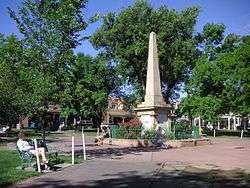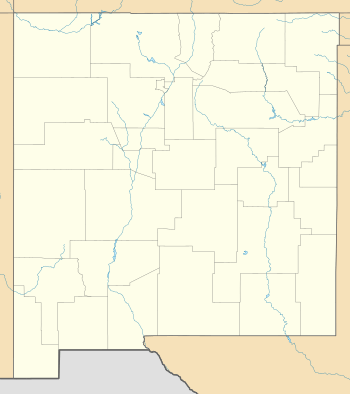Santa Fe Plaza
The Santa Fe Plaza is a National Historic Landmark in downtown Santa Fe, New Mexico in the style of traditional Spanish-American colonial cities. The plaza, or "city-square", was originally, and is still to this day, the center gathering place in town. Many know it as "the heart of Santa Fe". The landmark has since grown into a playground for many tourists interested in Spanish, Native American, and Mexican cultures, and includes music, design, jewelry, art and dance. Known to locals simply as the "Plaza," it is home to annual events including Fiestas de Santa Fe, the Spanish Market, the Santa Fe Bandstand, and the Santa Fe Indian Market.
Santa Fe Plaza | |
 Santa Fe Plaza in 2006 | |
  | |
| Location | Santa Fe Plaza, Santa Fe, New Mexico |
|---|---|
| Coordinates | 35°41′14.7474″N 105°56′18.6714″W |
| Area | 2 acres (0.81 ha) |
| Built | 1821 |
| Part of | Santa Fe Historic District (ID73001150[1]) |
| NRHP reference No. | 66000491[1] |
| NMSRCP No. | 260 |
| Significant dates | |
| Added to NRHP | October 15, 1966 |
| Designated NHL | December 19, 1960[2] |
| Designated CP | July 23, 1973 |
| Designated NMSRCP | September 29, 1972 |
Listed on the National Register of Historic Places, the Plaza consists of a central park lined with grass, trees, and benches, which add to the cultural scenery, especially at Christmas time when the Plaza streets and buildings glow with farolitos and the occasional luminaria, and trees glow with lights. Included in the park is an American Indian War Memorial monument as well as a performing arts stage.
Encompassed in the general Plaza area are historic monuments, restaurants, businesses and art galleries, including the Palace of the Governors (the oldest public building in the U.S.), the New Mexico Museum of Art, Cathedral Basilica of Saint Francis of Assisi, and the Loretto Chapel. In true pueblo fashion, the Plaza architecture is traditional adobe. Just 16 miles (26 km) from the Santa Fe ski basin, the Plaza dates back to the early 17th century when Santa Fe was settled by conquistadors. Until the mid-19th century, the Plaza lacked landscaping, and ownership of the area transitioned between the Spaniards and the Mexicans throughout the earlier years.
Historical context
Santa Fe Plaza has been the commercial, social and political center of Santa Fe since c. 1610 when it was established by Don Pedro de Peralta. The original Plaza was a presidio (fort) surrounded by a large defensive wall that enclosed residences, barracks, a chapel, a prison and the Governor's palace. Eventually the wall gave way to large houses built by high-ranking Spanish officers and officials. In 1822 the famed Santa Fe Trail, a trade route connecting New Mexico with Missouri, was opened with its western terminus at the Santa Fe Plaza.[3]
Today the Plaza is ringed by structures in the Pueblo, Spanish and Territorial styles that reflect its diverse history. Among the most noted are the original palacio, the Palace of the Governors, built between 1610 and 1612 and San Miguel Mission, a noted landmark c. 1640, and one of the oldest churches in the United States.[4]
The Plaza is Santa Fe's historic, cultural and geographic center. In the early days, it was found at the end of El Camino Real (the Spanish Royal Road from Mexico City), the Santa Fe Trail, and the Old Pecos Trail. Today, the Plaza is surrounded by restaurants, shops and museums and it serves as a gathering place for both locals and tourists. Many seasonal community events are held at the Plaza, and it is then filled to capacity with people enjoying the magic that is 'The City Different'.[5]
Monument

The monument in the plaza is inscribed, on its four sides:
TO THE HEROES OF THE FEDERAL ARMY WHO FELL AT THE BATTLE OF VALVERDE, FOUGHT WITH THE REBELS FEBUARY 21, 1862
TO THE HEROES WHO HAVE FALLEN IN THE VARIOUS BATTLES WITH
SAVAGEINDIANS IN THE TERRITORY OF NEW MEXICOTO THE HEROES OF THE FEDERAL ARMY WHO FELL AT THE BATTLES OF CANON DEL APACHE AND PIGEON'S RANCH (LA GLORIETA) FOUGHT WITH THE REBELS MARCH 28, 1863 AND TO THOSE WHO FELL AT THE BATTLE FOUGHT WITH THE REBELS AT PERALTA APRIL 15, 1862.
ERECTED BY THE PEOPLE OF NEW MEXICO THROUGH THEIR LEGISLATURES OF 1866 - 7 - 8. MAY THE UNION BE PERPETUAL.
An interpretive plaque nearby explains the context, that the monument was dedicated in 1868 at a time of intense strife which had set northerner against southerner, white against Indian, Indian against Indian, and notes that prejudices reflected in the wording hopefully dissolve eventually. Note that "FEBUARY" is misspelled.
In August 1974, an unknown man wearing a hard hat walked into the plaza and chiseled out the word "savage" from the monument. His identity has never been learned. The obelisk, which some consider offensive, had not been otherwise been altered by city management because the plaza received federal aid[7] as a historic site in 1972-3, until the tip of the obelisk was removed in the midst of the 2020 protests with concern about the stability of the upper sections cited as a safety motivation.
However, various unauthorised alterations have been made to the obelisk, including the markering of 'courageous' in 2014 over the area where 'savage' had been previously chiseled, and in 2020 further blunt damage to the side of the obelisk previously chiseled along with spray-painting over other parts.
See also
References
- "National Register Information System". National Register of Historic Places. National Park Service. July 9, 2010.
- "National Historic Landmarks Survey, New Mexico" (PDF). National Park Service. Retrieved January 7, 2017.
- Santa Fe National Historic Trail, National Park Service
- Santa Fe Plaza-American Southwest-A National Register of Historic Places Travel Itinerary
- Santa Fe Unlimited | Santa Fe Plaza
- Transcribed from the monument, January 2018. The "Battle of Canon del Apache" mentioned may refer to the Battle of Apache Pass, July 15–16, 1862. The word 'savage' has been scratched out.
- Terrell, Steve (August 9, 2000). "City councilor agrees wording on monument is objectionable". Santa Fe New Mexican.